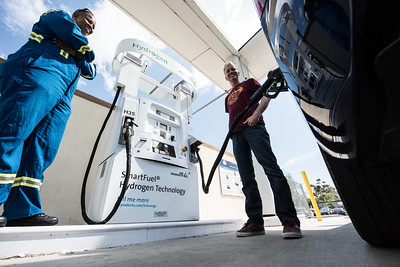
Introduction
Hydrogen fuel cells as a clean and effective energy source have attracted increasing attention recently. Hydrogen fuel cell technology presents a possible route toward a sustainable future as the world looks for alternative solutions to address climate change and reduce dependency on fossil fuels.
What is Hydrogen Fuel Cell Technology?
Hydrogen fuel cell technology is a clean and efficient energy conversion system that generates electricity by combining hydrogen and oxygen in an electrochemical reaction. It operates based on the principles of electrochemistry and relies on the properties of hydrogen and oxygen to produce electricity and water vapor as byproducts.
How does Hydrogen Fuel Cell Technology work?
The hydrogen fuel cell works by allowing hydrogen ions (protons) to pass through the electrolyte, while electrons flow through an external circuit, generating electricity. The electrons and protons then combine with oxygen at the cathode, producing water vapor as a byproduct.
This electrochemical process is highly efficient and does not produce harmful emissions. It offers several advantages, including high energy conversion efficiency, zero greenhouse gas emissions (when hydrogen is produced from renewable sources), and the ability to provide continuous power as long as fuel and oxidant inputs are available.
Advantages of Hydrogen Fuel Cell Technology
Clean and Environmentally Friendly:
The only byproduct of the electrochemical reaction that produces energy in hydrogen fuel cells, which combine hydrogen and oxygen, is water vapor. Because it doesn’t emit hazardous pollutants or greenhouse gases into the atmosphere, fuel cell technology is a clean and environmentally friendly alternative to fossil fuel energy.
High Energy Efficiency:
When compared to conventional combustion-based solutions, fuel cells are more energy efficient. They are usually capable of converting more than 50% of the energy contained in hydrogen into usable electricity.
Versatility and Application Flexibility:
Hydrogen fuel cells have a wide range of uses in an array of sectors. They work well for powering various kinds of vehicles, including cars, buses, trains, and even maritime vessels. Furthermore, fuel cells are used in stationary power generation to produce reliable, clean electricity for domestic, commercial, and industrial uses. As a power source for computers, cell phones, and other electronic devices, they can also be employed in portable devices.
Fast Refueling and a Longer Range:
Fuel cell vehicles offer several advantages over electric vehicles, especially in terms of refueling speed and range. It only takes a few minutes to refuel a hydrogen fuel cell car. This reduces concerns about electric vehicles’ lengthy charging durations. A further benefit of fuel cell vehicles is that they often have a longer driving range, enabling longer trips without the necessity of frequently refueling.
Scalability and Grid Support:
Hydrogen fuel cell systems are easily expandable or contractable to accommodate changing energy demands. Small, transportable fuel cells for personal devices to massive power production facilities are all feasible. Fuel cells may be scaled up to provide power decentralized, supporting grid stability and integrating intermittent renewable energy sources. Fuel cells have the potential to deliver a reliable and manageable power source, assisting in the balancing of energy grids and enhancing overall system effectiveness.
Energy Storage Potential:
Energy storage is a critical function for hydrogen fuel cells. The process of electrolysis can be used to make hydrogen from surplus electricity produced from renewable energy sources. When renewable energy supply is scarce or demand is high, the hydrogen that has been stored can be used in fuel cells to produce power. This ability to store energy in the form of hydrogen enables better integration of renewable energy sources and facilitates grid stability.
Energy Security:
Hydrogen fuel cell technology offers the potential to reduce our reliance on fossil fuels for the production of energy. Several resources, including biomass, natural gas, and energy from renewable sources can be used to create hydrogen. Fuel cell technology can improve energy security and reduce the geopolitical risks brought on by traditional energy sources by reducing reliance on fossil fuels and diversifying energy sources.
Market Size – Hydrogen Fuel Cell Technology
GRAND VIEW RESEARCH
According to market research firm Grand View Research the size of the worldwide fuel cell market is estimated to be USD 6.3 billion in 2022, and it is projected to grow at a CAGR of 19.9% from 2023 to 2030. One of the main causes supporting the expansion is an increase in the need for unconventional energy sources. The demand is anticipated to increase as a result of expanding public-private partnerships and less environmental impact. Governments from all around the world are expected to assist the developments by funding R&D initiatives and appropriate financing programs, among other things.
Due to the rising demand for fuel cells from distributed generation facilities and backup power applications, stationary fuel cells accounted for a market share of more than 69.0% in 2022 and led the global market in terms of revenue.
Due to the increased interest in fuel cell-powered forklifts and the expansion of R&D efforts in Europe’s advanced economies, the transportation sector is anticipated to grow at the fastest rate. Personal electronics, portable goods, laptops, mobile phones, APUs, and consumer goods are just a few examples of applications for portable fuel cells. The market is also anticipated to expand due to greater R&D efforts being made in developed and developing nations to create hybrid vehicles that run on hydrogen fuel.
More than 67.0% of the units sold globally in 2022 were proton exchange membrane fuel cells (PEMFC). Forklifts, vehicles, telephones, primary systems, and backup power systems are just a few of the applications where PEMFC is commonly used. One important aspect that will increase their demand during the projection period is their versatility.
FORTUNE BUSINESS INSIGHTS
As per market research firm Fortune Business Insights, the size of the global fuel cell market was estimated at USD 4.58 billion in 2021, and it is anticipated to increase to USD 36.41 billion by 2029 from USD 5.9 billion in 2022, at a CAGR of 29.7%.
The market is segmented by type into solid oxide, phosphoric acid fuel cell, proton exchange membrane fuel cell (PEMFC), and others. The Proton Exchange Membrane Fuel Cell (PEMFC) market segment holds the majority of the market share. The increased demand for PEMFCs is brought on by several advantages including fuel input flexibility, compact design, lightweight, low cost, and electrolyte solidity.
During the projected period, it is anticipated that the Solid Oxide Fuel Cell (SOFC) segment will expand significantly. Stacks’ improved efficiency and higher grade heat have helped SOFC acquire a sizable stake in the Ene-Farm Programme. Prime power shipments to the US and Korea have grown by units, which is related to the net growth in SOFC shipment capacity.
MARKET RESEARCH FUTURE
According to Market Research Future, In 2021, the market size for hydrogen fuel cells was estimated at USD 1.98 billion. According to projections, the Hydrogen Fuel Cells market will increase from USD 2.48 billion in 2022 to USD 11.87 billion in 2030, with a compound annual growth rate (CAGR) of 25.09% over the forecast period (2022 – 2030). The primary market factors accelerating market expansion are rising public and private investments in developing and establishing hydrogen fuel cell manufacturing facilities.
Type-based segmentation of the hydrogen fuel cell market includes air-cooled and water-cooled types. Due to its greater cooling effect, the water-cooled variant accounted for the majority of revenue generated by hydrogen fuel cells. However, because it warms up considerably more quickly and doesn’t run the risk of coolant freezing, the air-cooled kind has the fastest rate of growth.
The analysis covers market information for North America, Europe, Asia-Pacific, and the rest of the world, organized by region. The market for hydrogen fuel cells in North America reached $.84 billion in 2021 and is anticipated to increase at a substantial CAGR throughout the research period. This is due to the government’s increased research and development initiatives, incentives, and subsidies for hydrogen fuel cell vehicles, as well as government funding and spending that has driven the region’s hydrogen fuel cell industry. Additionally, the hydrogen fuel cell market in the US saw the highest share of the market, while the market in Canada had the fastest rate of growth.
BCC RESEARCH
In 2021, the market for hydrogen fuel cells was worth $6.6 billion worldwide. At a compound annual growth rate (CAGR) of 21.0% between 2022 and 2027, the market should increase from $7.5 billion in 2022 to $19.5 billion by 2027.
This study examines the usage of stationary fuel cells for both mobility and stationary power generation and storage.
The fuel cell market is divided into two categories: a) fuel cell type; and b) use. The two main fuel cell types on the market are proton exchange membrane fuel cells (PEMFC) and solid oxide fuel cells. The applications taken into account in this study are vehicle propulsion systems, stationary power supply units, auxiliary power units (APU), and combined heating and power (CHP).
Key Players in Hydrogen Fuel Cell Technology
Several companies are actively engaged in the research, development, manufacturing, and use of hydrogen fuel cell technology.
- Ballard Power Systems: The Company specializes in proton exchange membrane (PEM) fuel cells for a range of uses, including stationary electricity, material handling, and transportation. Ballard is well-known in the automobile industry and provides major automobile manufacturers with fuel cell technology.
- Plug Power Inc.: The pioneer in hydrogen fuel cell technology for the logistics and material handling sectors is Plug Power Inc. Forklifts, warehouse vehicles, and other types of electric-powered industrial equipment are the company’s primary targets for its fuel cell solutions. Along with complete services, Plug Power also provides hydrogen infrastructure development and maintenance.
- Bloom Energy: Solid oxide fuel cell (SOFC) technology is an area of expertise of Bloom Energy. The company creates and produces fuel cell systems for on-site, reliable power generation. Data centers, office buildings, and manufacturing facilities are just a few of the places where fuel cells from Bloom Energy are used.
- AFC Energy: Alkaline fuel cell technology is the focus of the UK-based company AFC Energy. The business creates low-cost, high-efficiency alkaline fuel cells for a range of uses, including microgrids and stationary power generation. The primary goal of AFC Energy is to advance fuel cell technology through research and business collaborations.
- Toyota: Toyota, a well-known automaker, has significantly invested in the hydrogen fuel cell industry. The company created the Toyota Mirai, a hydrogen fuel cell car that has gained attention for its cutting-edge strategy to zero-emission transportation. Toyota actively contributes to the development of hydrogen infrastructure and fuel cell technology.
- Hyundai: Hyundai is yet another significant player in the market for hydrogen fuel cell cars. Hyundai has unveiled the Hyundai NEXO, a fuel cell electric vehicle (FCEV) that exemplifies the company’s dedication to environmentally friendly transportation. Hyundai wants to increase its market share and has set out to accelerate the adoption of hydrogen fuel cell vehicles.
- Nikola Corporation: Nikola Corporation is a company that develops battery-electric and hydrogen fuel cell cars for the transportation sector. With its hydrogen fuel cell truck models, the business seeks to revolutionize the trucking industry by offering long-distance, zero-emission transportation options.
- Doosan Fuel Cell is a leading supplier of stationary fuel cell systems and is a subsidiary of Doosan Corporation. The company provides integrated energy solutions for a range of applications, including the residential, commercial, and industrial sectors. It also offers fuel cell systems for power generation.
Factors Driving the Future Growth of Hydrogen Fuel Cell Technology
Hydrogen fuel cell technology is poised for significant growth in the coming years. Several key factors are driving the future expansion of this technology:
Environmental Concerns and Climate Goals:
The adoption of clean energy solutions is being sparked by rising concerns over climate change and the requirement to cut greenhouse gas emissions. When compared to conventional fossil fuel-based systems, hydrogen fuel cell technology offers a carbon-neutral or carbon-free alternative, making it a desirable choice for organizations, businesses, and individuals aiming to achieve sustainability.
Government Support and Policies:
To promote the development and implementation of hydrogen fuel cell technology, governments all over the world are putting supportive laws and regulations into place. The promotion of fuel cell system research, development, and commercialization involves financial incentives, tax credits, grants, and funding schemes. Government programs are essential for fostering a thriving corporate climate and spurring market expansion.
Technological Advancements:
Ongoing research and development activities are enhancing the functionality, effectiveness, and longevity of hydrogen fuel cell devices. Fuel cells are becoming more affordable, more energy efficient, and have a longer life cycle thanks to developments in catalyst materials, membrane technology, and system design. As technology develops, it becomes more commercially viable and appealing for a variety of uses, which promotes market growth.
Applications across a Range of Industries:
Hydrogen fuel cells are adaptable and have a range of uses. Fuel cells are used in stationary power generation, backup power systems, material handling equipment, aerospace, and other industries in addition to transportation, which includes personal vehicles and public transportation. The variety of applications increases the market potential and creates new growth prospects.
Infrastructure Development:
The widespread deployment of fuel cell technology depends on the creation of a reliable hydrogen infrastructure. The cost of fuel cell cars and stationary power systems is decreasing as a result of public and commercial investments in hydrogen refueling stations, hydrogen manufacturing facilities, and distribution networks. The market penetration of hydrogen fuel cell technology is significantly increased by infrastructure expansion.
Partnerships and Collaborations:
Industry stakeholders’ cooperation, including that of governmental bodies, academic institutions, and private businesses, is essential to the development of fuel cell technology. Partnerships speed up technological improvements and market expansion by facilitating knowledge exchange, collaborative research and development projects, and resource pooling. Collaboration also aids in overcoming issues with standardization, cost-cutting, and scale-up.
Energy Storage Potential:
Hydrogen fuel cells could be used as energy storage devices. Electrolysis can be used to create hydrogen using extra electricity produced from renewable resources. Fuel cells can later use the stored hydrogen to turn it back into electricity at times of high energy demand or when the availability of renewable energy sources is constrained. Fuel cell energy storage aids in grid balancing and encourages the incorporation of sporadic renewable energy sources.
Challenges and Limitations
Some of the key challenges associated with hydrogen fuel cells are:
Cost:
Compared to other energy technologies, the high cost of hydrogen fuel cell devices is one of the main obstacles. The whole system cost is influenced by the price of fuel cell components such as platinum catalysts, membranes, and balance-of-plant parts. The goal of research and development is to lower the cost through improvements in materials, production methods, and economies of scale.
Infrastructure:
The primary obstacle to the widespread use of hydrogen fuel cell vehicles is the restricted availability of hydrogen refueling infrastructure. Governments, energy suppliers, and commercial organizations must work together and invest considerable amounts of money to establish a vast network of refueling stations. For hydrogen fuel to be convenient and accessible for use in vehicles and other applications hydrogen infrastructure development is essential.
Production of Hydrogen:
The production of hydrogen, especially from fossil fuels, raises questions regarding carbon emissions and the overall effects on the environment. Although clean hydrogen can be produced using renewable techniques like water electrolysis, further research is required to improve the scalability and economics of renewable hydrogen production technologies. The long-term viability of hydrogen fuel cell technology depends on achieving sustainable and affordable hydrogen production technologies.
Storage and Distribution:
Hydrogen has a low energy density per unit volume, necessitating specialized infrastructure for storage and distribution. Storage techniques using compressed gas or liquid hydrogen provide difficulties in terms of safety, volumetric effectiveness, and logistical transfer. For fuel cell technology to be used widely, systems for storing and distributing hydrogen must be developed that are effective, secure, and cost-effective.
Lifespan and Durability:
Fuel cell longevity and durability are crucial components for commercial viability. Fuel cells’ performance and longevity may be affected by the deterioration of their membranes, catalysts, and other parts over time. To increase the reliability and commercial viability of fuel cell systems, improvements in durability, robustness, and maintenance needs are required.
Scaling up and Manufacturing:
As the market demand for fuel cell systems increases, scaling up production and manufacturing processes becomes a challenge. Achieving economies of scale, optimizing manufacturing techniques, and ensuring consistent quality control is essential for cost reduction and mass deployment of fuel cell systems.
Government Initiatives to Promote Hydrogen Fuel Cell Technology
Governments around the world have recognized its potential and have taken various initiatives to promote the development, adoption, and commercialization of hydrogen fuel cell technology. Here are some notable initiatives by different countries:
Japan:
- Japan has been a pioneer in promoting hydrogen fuel cell technology. It launched the “Basic Hydrogen Strategy” in 2017, outlining its vision for a hydrogen-based society.
- The Japanese government has set ambitious targets, aiming to deploy 800,000 fuel cell vehicles and install 900 hydrogen refueling stations by 2030.
- It provides subsidies and tax incentives for purchasing fuel cell vehicles, along with support for hydrogen infrastructure development.
Germany:
- Germany has a comprehensive strategy for the development of hydrogen technologies called the “National Hydrogen Strategy.”
- The German government has allocated significant funding to support research, development, and deployment of hydrogen technologies, including fuel cells.
- It aims to have 400 hydrogen refueling stations and 5 GW of installed electrolysis capacity by 2030.
South Korea:
- South Korea launched the “Hydrogen Economy Roadmap” in 2019, with a vision to become a leading player in the hydrogen economy.
- The government has established targets to deploy 6.2 million fuel cell vehicles and install 1,200 hydrogen refueling stations by 2040.
- It offers various incentives such as tax breaks, subsidies, and R&D support to promote the adoption of fuel cell vehicles and hydrogen infrastructure.
China:
- China has recognized the importance of hydrogen fuel cell technology and included it in its long-term energy plans.
- The government aims to build a comprehensive hydrogen infrastructure network, with a target of 1,000 hydrogen refueling stations by 2030.
- It provides financial support, research grants, and tax incentives to accelerate the development and adoption of fuel cell technologies.
United States:
- The United States has taken several initiatives to support the growth of hydrogen fuel cell technology.
- The Department of Energy has funded research and development programs for fuel cell systems and hydrogen production technologies.
- Various states, such as California, have set ambitious targets for fuel cell vehicle adoption and hydrogen refueling infrastructure expansion.
- The federal government offers tax credits and grants to incentivize the use of fuel-cell vehicles and promote hydrogen infrastructure development.
Australia:
- Australia has recognized the potential of hydrogen as an energy carrier and has developed the “National Hydrogen Strategy.”
- The government aims to establish Australia as a major hydrogen exporter, with an emphasis on renewable hydrogen production and fuel cell technologies.
- It provides funding support for research, development, and demonstration projects related to hydrogen fuel cells.
India:
National Hydrogen Energy Mission:
- In February 2021, India announced the launch of the National Hydrogen Energy Mission (NHEM) to promote hydrogen energy and fuel cell technology.
- The mission aims to accelerate the development, deployment, and scaling up of hydrogen and fuel cell technologies in India.
- It focuses on creating a comprehensive ecosystem for hydrogen production, storage, and distribution, as well as driving research and development activities.
National Hydrogen Energy Roadmap:
- The Indian government has initiated the development of a National Hydrogen Energy Roadmap to outline a strategic plan for hydrogen adoption and utilization.
- The roadmap aims to identify key sectors for hydrogen application, such as transportation, industry, and power generation, and establish targets and timelines for their implementation.
- It focuses on promoting green hydrogen production using renewable energy sources and aims to foster domestic manufacturing of fuel cell systems and related components.
Policy Support and Funding:
- The Indian government provides policy support, incentives, and funding to promote hydrogen fuel cell technology.
- It offers subsidies and tax incentives for the purchase of fuel cell vehicles and supports research and development projects through grants and funding schemes.
- Various state governments have also announced policies and incentives to encourage the adoption of fuel-cell vehicles and the development of hydrogen infrastructure.
Hydrogen Corridor:
- India plans to develop a “Hydrogen Corridor” that will connect various cities through hydrogen fueling stations.
- The corridor aims to establish a network of hydrogen refueling infrastructure, initially focusing on key transportation routes and industrial clusters.
- The government aims to set up pilot projects and demonstration units along the corridor to showcase the viability and benefits of hydrogen fuel cell technology.
International Collaborations:
- India has engaged in international collaborations to leverage global expertise and promote hydrogen fuel cell technology.
- The country has joined initiatives such as the Hydrogen Initiative under the Clean Energy Ministerial and the International Partnership for Hydrogen and Fuel Cells in the Economy.
- These collaborations facilitate knowledge exchange, research cooperation, and technology transfer to accelerate the growth of hydrogen fuel cell technology in India.







